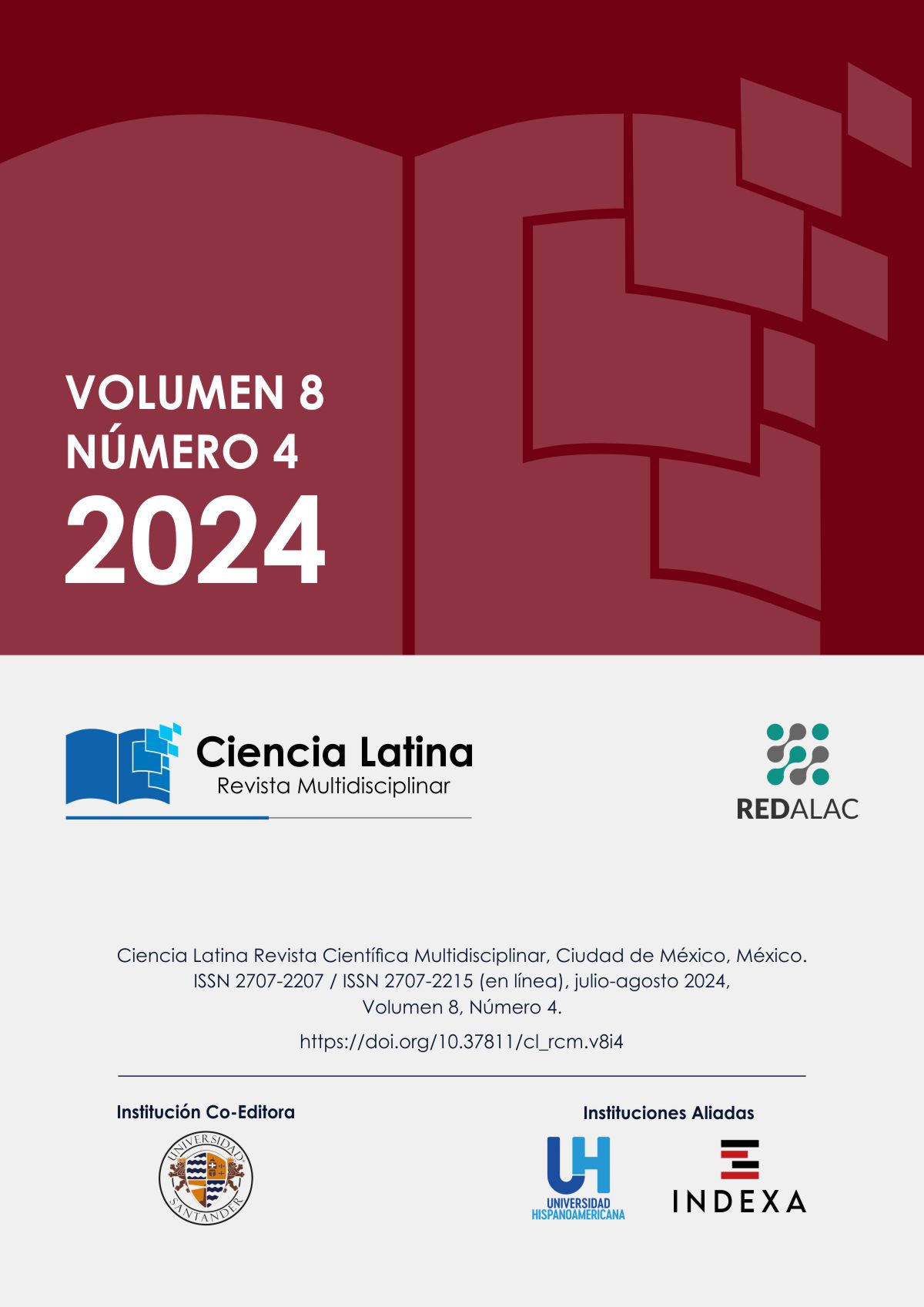Delirium en el anciano: guía clínica integral para su diagnóstico y tratamiento
Resumen
Introducción: Los ancianos tienen un mayor riesgo de presentar delirium debido a factores como la edad avanzada, demencia y deterioro cognitivo y funcional. Su prevalencia varía según el grupo de pacientes y el entorno. Objetivo: Sintetizar y analizar críticamente el conocimiento actual sobre la definición, características clínicas, diagnóstico y tratamiento del delirium en ancianos. Metodología: Se realizó una búsqueda sistemática en bases de datos, utilizando términos MeSH y DeCs: “Delirium”, “Cognitive Dysfunction”, “Dementia”, “Aged”, “Clinical Protocols” y “Coronavirus Infections”. Se incluyeron artículos publicados hasta el 30 de mayo de 2021, seleccionando 50 artículos basados en criterios de inclusión y exclusión establecidos por los autores. Resultados: En los ancianos, el delirium ocurre por una falla cerebral que reduce la capacidad de respuesta a un factor estresante agudo, siendo la disfunción colinérgica el mecanismo más frecuente. Es común en pacientes hospitalizados, con una prevalencia del 23% en pacientes no quirúrgicos. En pacientes postquirúrgicos, la prevalencia varía, alcanzando hasta un 20% en aquellos sometidos a cirugía mayor. Las restricciones generadas por la pandemia de COVID-19 aumentaron la incidencia de delirium en ancianos, presentándose de manera más severa. Es esencial usar herramientas estandarizadas para la detección del delirium en la práctica clínica. No existen pruebas de laboratorio específicas para su diagnóstico y no se recomienda de rutina el uso de estudios de neuroimagen. Las estrategias no farmacológicas con componentes múltiples han demostrado reducir su incidencia. Conclusión: El delirium es una condición multifactorial que genera alta morbimortalidad en los ancianos. El manejo farmacológico sigue siendo un desafío en su tratamiento
Descargas
Citas
Fuchs, S., Bode, L., Ernst, J., Marquetand, J., von Känel, R., & Böttger, S. (2020). Delirium in elderly patients: Prospective prevalence across hospital services. General Hospital Psychiatry, 67, 19-25. https://doi.org/10.1016/j.genhosppsych.2020.08.010
Dahlstrom, E. B., Han, J. H., Healy, H., Kennedy, M., Arendts, G., Lee, J., Carpenter, C., et al. (2020). Delirium prevention and treatment in the emergency department (ED): A systematic review protocol. BMJ Open, 10(10), e037915. https://doi.org/10.1136/bmjopen-2020-037915
Hosker, C. M., & Bennett, M. I. (2016). Delirium and agitation at the end of life. BMJ, 353, i3085. https://doi.org/10.1136/bmj.i3085
Wilson, J. E., Mart, M. F., Cunningham, C., Shehabi, Y., Girard, T. D., MacLullich, A. M. J., Slooter, A. J. C., & Ely, E. W. (2020). Delirium. Nature Reviews Disease Primers, 6(1), 90. https://doi.org/10.1038/s41572-020-00223-4
Koirala, B., Hansen, B. R., Hosie, A., Budhathoki, C., Seal, S., Beaman, A., et al. (2020). Delirium point prevalence studies in inpatient settings: A systematic review and meta-analysis. Journal of Clinical Nursing, 29(13-14), 2083-2092. https://doi.org/10.1111/jocn.15219
McCoy, T. H. Jr, Chaukos, D. C., Snapper, L. A., Hart, K. L., Stern, T. A., & Perlis, R. H. (2017). Enhancing delirium case definitions in electronic health records using clinical free text. Psychosomatics, 58(2), 113-120. https://doi.org/10.1016/j.psym.2016.10.007
Casey, P., Cross, W., Mart, M. W., Baldwin, C., Riddell, K., & Dārziņš, P. (2019). Hospital discharge data under-reports delirium occurrence: Results from a point prevalence survey of delirium in a major Australian health service. Internal Medicine Journal, 49(3), 338-344. https://doi.org/10.1111/imj.14066
Copeland, C., & Barron, D. T. (2020). Delirium: An essential component in undergraduate training? Nurse Education Today, 85, 104211. https://doi.org/10.1016/j.nedt.2019.104211
Adamis, D., Treloar, A., Martin, F. C., & Macdonald, A. J. (2007). A brief review of the history of delirium as a mental disorder. History of Psychiatry, 18(72 Pt 4), 459-469. https://doi.org/10.1177/0957154X07076467
Hshieh, T. T., Inouye, S. K., & Oh, E. S. (2020). Delirium in the elderly. Clinical Geriatrics Medicine, 36(2), 183-199. https://doi.org/10.1016/j.cger.2019.11.001
American Psychiatric Association. (2013). Diagnostic and statistical manual of mental disorders (5th ed.). https://doi.org/10.1176/appi.books.9780890425596.dsm05
Marcantonio, E. R. (2017). Delirium in hospitalized older adults. New England Journal of Medicine, 377(15), 1456-1466. https://doi.org/10.1056/NEJMcp1605501
Gibb, K., Seeley, A., Quinn, T., Siddiqi, N., Shenkin, S., Rockwood, K., et al. (2020). The consistent burden in published estimates of delirium occurrence in medical inpatients over four decades: A systematic review and meta-analysis study. Age and Ageing, 49(3), 352-360. https://doi.org/10.1093/ageing/afaa040
Watt, J., Tricco, A. C., Talbot-Hamon, C., Pham, B., Rios, P., Grudniewicz, A., et al. (2018). Identifying older adults at risk of delirium following elective surgery: A systematic review and meta-analysis. Journal of General Internal Medicine, 33(4), 500-509. https://doi.org/10.1007/s11606-017-4204-x
Greaves, D., Psaltis, P. J., Ross, T. J., Davis, D., Smith, A. E., Boord, M. S., et al. (2019). Cognitive outcomes following coronary artery bypass grafting: A systematic review and meta-analysis of 91,829 patients. International Journal of Cardiology, 289, 43-49.
https://doi.org/10.1016/j.ijcard.2019.04.065
Inouye, S. K., Westendorp, R. G., & Saczynski, J. S. (2014). Delirium in elderly people. Lancet, 383(9920), 911-922. https://doi.org/10.1016/S0140-6736(13)60688-1
Watt, C. L., Momoli, F., Ansari, M. T., Sikora, L., Bush, S. H., Hosie, A., et al. (2019). The incidence and prevalence of delirium across palliative care settings: A systematic review. Palliative Medicine, 33(8), 865-877. https://doi.org/10.1177/0269216319854944
Krewulak, K. D., Stelfox, H. T., Leigh, J. P., Ely, E. W., & Fiest, K. M. (2018). Incidence and prevalence of delirium subtypes in an adult ICU: A systematic review and meta-analysis. Critical Care Medicine, 46(12), 2029-2035. https://doi.org/10.1097/CCM.0000000000003402
Cunningham, C., Wilcockson, D. C., Campion, S., Lunnon, K., & Perry, V. H. (2005). Central and systemic endotoxin challenges exacerbate the local inflammatory response and increase neuronal death during chronic neurodegeneration. Journal of Neuroscience, 25(40), 9275-9284. https://doi.org/10.1523/JNEUROSCI.2614-05.2005
Sweeney, M. D., Kisler, K., Montagne, A., Toga, A. W., & Zlokovic, B. V. (2018). The role of brain vasculature in neurodegenerative disorders. Nature Neuroscience, 21(10), 1318-1331. https://doi.org/10.1038/s41593-018-0234-x
Alagiakrishnan, K., & Wiens, C. A. (2004). An approach to drug induced delirium in the elderly. Postgraduate Medical Journal, 80(945), 388-393. https://doi.org/10.1136/pgmj.2003.017236
Hshieh, T. T., Fong, T. G., Marcantonio, E. R., & Inouye, S. K. (2008). Cholinergic deficiency hypothesis in delirium: A synthesis of current evidence. Journal of Gerontology: Series A, Biological Sciences and Medical Sciences, 63(7), 764-772. https://doi.org/10.1093/gerona/63.7.764
Lauretani, F., Ceda, G. P., Maggio, M., Nardelli, A., Saccavini, M., & Ferrucci, L. (2010). Capturing side effects of medication to identify persons at risk of delirium. Aging Clinical and Experimental Research, 22(5-6), 456-458. https://doi.org/10.1007/BF03324944
Laurila, J. V., Laakkonen, M. L., Tilvis, R. S., & Pitkala, K. H. (2008). Predisposing and precipitating factors for delirium in a frail geriatric population. Journal of Psychosomatic Research, 65(3), 249-254. https://doi.org/10.1016/j.jpsychores.2008.05.026
Cirbus, J., MacLullich, A. M. J., Noel, C., Ely, E. W., Chandrasekhar, R., & Han, J. H. (2019). Delirium etiology subtypes and their effect on six-month function and cognition in older emergency department patients. International Psychogeriatrics, 31(2), 267-276. https://doi.org/10.1017/S1041610218000777
Meagher, D. J., Maclullich, A. M., & Laurila, J. V. (2008). Defining delirium for the International Classification of Diseases, 11th Revision. Journal of Psychosomatic Research, 65(3), 207-214. https://doi.org/10.1016/j.jpsychores.2008.05.015
Cole, M. G., Dendukuri, N., McCusker, J., & Han, L. (2003). An empirical study of different diagnostic criteria for delirium among elderly medical inpatients. Journal of Neuropsychiatry and Clinical Neurosciences, 15(2), 200-207. https://doi.org/10.1176/jnp.15.2.200
Laurila, J. V., Pitkala, K. H., Strandberg, T. E., & Tilvis, R. S. (2003). The impact of different diagnostic criteria on prevalence rates for delirium. Dementia and Geriatric Cognitive Disorders, 16(3), 156-162. https://doi.org/10.1159/000071004
van Velthuijsen, E. L., Zwakhalen, S. M., Warnier, R. M., Mulder, W. J., Verhey, F. R., & Kempen, G. I. (2016). Psychometric properties and feasibility of instruments for the detection of delirium in older hospitalized patients: A systematic review. International Journal of Geriatric Psychiatry, 31(9), 974-989. https://doi.org/10.1002/gps.4441
De, J., & Wand, A. P. (2015). Delirium screening: A systematic review of delirium screening tools in hospitalized patients. Gerontologist, 55(6), 1079-1099. https://doi.org/10.1093/geront/gnv100
Shenkin, S. D., Fox, C., Godfrey, M., Siddiqi, N., Goodacre, S., Young, J., et al. (2019). Delirium detection in older acute medical inpatients: A multicentre prospective comparative diagnostic test accuracy study of the 4AT and the Confusion Assessment Method. BMC Medicine, 17(1), 138. https://doi.org/10.1186/s12916-019-1367-9
Wei, L. A., Fearing, M. A., Sternberg, E. J., & Inouye, S. K. (2008). The Confusion Assessment Method: A systematic review of current usage. Journal of the American Geriatrics Society, 56(5), 823-830. https://doi.org/10.1111/j.1532-5415.2008.01674.x
Inouye, S. K., Kosar, C. M., Tommet, D., Schmitt, E. M., Puelle, M. R., Saczynski, J. S., Marcantonio, E. R., & Jones, R. N. (2014). The CAM-S: Development and validation of a new scoring system for delirium severity in two cohorts. Annals of Internal Medicine, 160(8), 526-533. https://doi.org/10.7326/M13-1927
Bellelli, G., Morandi, A., Davis, D. H., Mazzola, P., Turco, R., Gentile, S., et al. (2014). Validation of the 4AT, a new instrument for rapid delirium screening: A study in 234 hospitalised older people. Age and Ageing, 43(4), 496-502. https://doi.org/10.1093/ageing/afu021
MacLullich, A. M., Shenkin, S. D., Goodacre, S., Godfrey, M., Hanley, J., Stíobhairt, A., et al. (2019). The 4 'A's test for detecting delirium in acute medical patients: A diagnostic accuracy study. Health Technology Assessment, 23(40), 1-194. https://doi.org/10.3310/hta23400
Bergeron, N., Dubois, M. J., Dumont, M., Dial, S., & Skrobik, Y. (2001). Intensive Care Delirium Screening Checklist: Evaluation of a new screening tool. Intensive Care Medicine, 27(5), 859-864. https://doi.org/10.1007/s001340100909
Gusmao-Flores, D., Salluh, J. I., Chalhub, R. Á., & Quarantini, L. C. (2012). The Confusion Assessment Method for the Intensive Care Unit (CAM-ICU) and Intensive Care Delirium Screening Checklist (ICDSC) for the diagnosis of delirium: A systematic review and meta-analysis of clinical studies. Critical Care, 16(4), R115. https://doi.org/10.1186/cc11407
Inouye, S. K., Foreman, M. D., Mion, L. C., Katz, K. H., & Cooney, L. M. Jr. (2001). Nurses' recognition of delirium and its symptoms: Comparison of nurse and researcher ratings. Archives of Internal Medicine, 161(20), 2467-2473. https://doi.org/10.1001/archinte.161.20.2467
Hirao, K., Ohnishi, T., Matsuda, H., Nemoto, K., Hirata, Y., Yamashita, F., et al. (2006). Functional interactions between the entorhinal cortex and posterior cingulate cortex at the very early stage of Alzheimer's disease using brain perfusion single-photon emission computed tomography. Nuclear Medicine Communications, 27(2), 151-156. https://doi.org/10.1097/01.mnm.0000189783.39411.ef
Lai, M. M., & Wong Tin Niam, D. M. (2012). Intracranial cause of delirium: Computed tomography yield and predictive factors. Internal Medicine Journal, 42(4), 422-427. https://doi.org/10.1111/j.1445-5994.2010.02400.x
Inouye, S. K., Zhang, Y., Jones, R. N., Kiely, D. K., Yang, F., & Marcantonio, E. R. (2007). Risk factors for delirium at discharge: Development and validation of a predictive model. Archives of Internal Medicine, 167(13), 1406-1413. https://doi.org/10.1001/archinte.167.13.1406
Hshieh, T. T., Yue, J., Oh, E., Puelle, M., Dowal, S., Travison, T., & Inouye, S. K. (2015). Effectiveness of multicomponent nonpharmacological delirium interventions: A meta-analysis. JAMA Internal Medicine, 175(4), 512-520. https://doi.org/10.1001/jamainternmed.2014.7779
Siddiqi, N., Harrison, J. K., Clegg, A., Teale, E. A., Young, J., Taylor, J., & Simpkins, S. A. (2016). Interventions for preventing delirium in hospitalised non-ICU patients. Cochrane Database of Systematic Reviews, 3, CD005563. https://doi.org/10.1002/14651858.CD005563.pub3
Neufeld, K. J., Yue, J., Robinson, T. N., Inouye, S. K., & Needham, D. M. (2016). Antipsychotic medication for prevention and treatment of delirium in hospitalized adults: A systematic review and meta-analysis. Journal of the American Geriatrics Society, 64(4), 705-714. https://doi.org/10.1111/jgs.14076
Agar, M. R., Lawlor, P. G., Quinn, S., Draper, B., Caplan, G. A., Rowett, D., et al. (2017). Efficacy of oral risperidone, haloperidol, or placebo for symptoms of delirium among patients in palliative care: A randomized clinical trial. JAMA Internal Medicine, 177(1), 34-42. https://doi.org/10.1001/jamainternmed.2016.7491
O'Hanlon, S., & Inouye, S. K. (2020). Delirium: A missing piece in the COVID-19 pandemic puzzle. Age and Ageing, 49(4), 497-498. https://doi.org/10.1093/ageing/afaa094
Kotfis, K., Williams Roberson, S., Wilson, J. E., Dabrowski, W., Pun, B. T., & Ely, E. W. (2020). COVID-19: ICU delirium management during the SARS-CoV-2 pandemic. Critical Care, 24(1), 176. https://doi.org/10.1186/s13054-020-02882-x
Helms, J., Kremer, S., Merdji, H., Clere-Jehl, R., Schenck, M., Kummerlen, C., et al. (2020). Neurologic features in severe SARS-CoV-2 infection. New England Journal of Medicine, 382(23), 2268-2270. https://doi.org/10.1056/NEJMc2008597
LaHue, S. C., James, T. C., Newman, J. C., Esmaili, A. M., Ormseth, C. H., & Ely, E. W. (2020). Collaborative delirium prevention in the age of COVID-19. Journal of the American Geriatrics Society, 68(5), 947-949. https://doi.org/10.1111/jgs.16480
Devlin, J. W., Skrobik, Y., Gélinas, C., Needham, D. M., Slooter, A. J. C., et al. (2018). Clinical practice guidelines for the prevention and management of pain, agitation/sedation, delirium, immobility, and sleep disruption in adult patients in the ICU. Critical
Alegría Bernal, C. M. (2024). La Norma Iso 21001 Y Su Aplicación En El Ámbito De La Educación Superior. Estudios Y Perspectivas Revista Científica Y Académica , 4(2), 374–389. https://doi.org/10.61384/r.c.a.v4i2.228
Zeballos , F. (2024). Shock Séptico en Terapia Intensiva Adulto del Hospital San Juan de Dios de la Ciudad de Tarija: Revista Científica de Salud y Desarrollo Humano. Revista Científica De Salud Y Desarrollo Humano, 5(2), 179–191. https://doi.org/10.61368/r.s.d.h.v5i2.128
Gallegos Medina, S. L. (2024). Desarrollo Sociocultural durante la Primera Infancia desde una Perspectiva Psicológica. Emergentes - Revista Científica, 4(1), 12–21. https://doi.org/10.60112/erc.v4i1.86
Montes López, V. (2023). Socioeconomic Inequalities in Health: A Challenge for Equity. Revista Veritas De Difusão Científica, 4(1), 18–29. https://doi.org/10.61616/rvdc.v4i1.35
Fernández C., F. (2024). Determinación De Erodabilidad En Áreas De Influencia Cuenca Poopo Región Andina De Bolivia. Horizonte Académico, 4(4), 63–78. Recuperado a partir de https://horizonteacademico.org/index.php/horizonte/article/view/19
Medina Nolasco, E. K., Mendoza Buleje, E. R., Vilca Apaza, G. R., Mamani Fernández, N. N., & Alfaro Campos, K. (2024). Tamizaje de cáncer de cuello uterino en mujeres de una región Andina del Perú. Arandu UTIC, 11(1), 50–63. https://doi.org/10.69639/arandu.v11i1.177
Da Silva Santos , F., & López Vargas , R. (2020). Efecto del Estrés en la Función Inmune en Pacientes con Enfermedades Autoinmunes: una Revisión de Estudios Latinoamericanos. Revista Científica De Salud Y Desarrollo Humano, 1(1), 46–59. https://doi.org/10.61368/r.s.d.h.v1i1.9
Derechos de autor 2024 Danna Sarmiento Dickson , Luis Felipe Ordosgoitia Dickson, Daniela Álzate Hoyos, Sebastián Enrique Santana Araujo, Daniela María Herdenes García, Eyver Enrique Ibarra Olivella, Oscar Vergara Serpa

Esta obra está bajo licencia internacional Creative Commons Reconocimiento 4.0.











.png)




















.png)
1.png)


